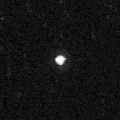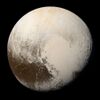Astronomy:(55565) 2002 AW197
 Hubble Space Telescope image of 2002 AW197 taken in 2006 | |
| Discovery[1][2] | |
|---|---|
| Discovered by | Palomar Obs. (team) |
| Discovery site | Palomar Obs. |
| Discovery date | 10 January 2002 |
| Designations | |
| 2002 AW197 | |
| Minor planet category | TNO[3] · cubewano[4] p-DP[5] · extended[6] distant[1] |
| Orbital characteristics[3] | |
| Epoch 31 May 2020 (JD 2459000.5) | |
| Uncertainty parameter 3 | |
| Observation arc | 21.23 yr (7,756 d) |
| Earliest precovery date | 29 December 1997 |
| |{{{apsis}}}|helion}} | 53.161 AU |
| |{{{apsis}}}|helion}} | 40.922 AU |
| 47.042 AU | |
| Eccentricity | 0.13009 |
| Orbital period | 322.65 yr (117,848 d) |
| Mean anomaly | 294.532° |
| Mean motion | 0° 0m 10.998s / day |
| Inclination | 24.451° |
| Longitude of ascending node | 297.606° |
| |{{{apsis}}}|helion}} | ≈ 5 May 2078[7] ±4 days |
| 297.494° | |
| Physical characteristics | |
| Mean diameter | 768±39 km[8] 734±116 km[9] 700±50 km[10][11] 886 km[12] |
| Rotation period | 8.87±0.01 h[13] 8.78±0.05 h[14] 8.86±0.01 h[15] |
| Geometric albedo | 0.112+0.012 −0.011[8] |
| IR[16][17] · (moderately red) B–V = 0.920±0.020[18] V–R = 0.560±0.020[18] V–I = 1.170±0.010[17] | |
| Apparent magnitude | 20.0 (opposition)[19][20] |
| Absolute magnitude (H) | 3.568±0.046 (V)[21] 3.156±0.059 (R)[22] 3.3 (assumed)[3] |
(55565) 2002 AW197 (provisional designation 2002 AW197) is a classical, non-resonant trans-Neptunian object from the Kuiper belt in the outermost region of the Solar System, also known as a cubewano. With a likely diameter of at least 700 kilometers (430 miles), it is approximately tied with 2002 MS4 and 2013 FY27 (to within measurement uncertainties) as the largest unnamed object in the Solar System. It was discovered at Palomar Observatory in 2002.
Its rotation period is 8.8 hours and it is a moderately red color.[16] Tancredi notes that photometric observations suggest that it is a spheroid with a high albedo and small albedo spots.[23] However, its low albedo suggests it does not have planetary geology, as it should if it were a dwarf planet.
Description
Discovery
2002 AW197 was discovered on 10 January 2002, by astronomers at the Palomar Observatory in California.[1] Astronomers involved in the discovery were Michael Brown, Chad Trujillo, Eleanor Helin, Michael Hicks, Kenneth Lawrence and Steven H. Pravdo.[2] It is located near the Kuiper cliff.
Orbit and classification
2002 AW197 orbits the Sun at a distance of 40.9–53.2 AU once every 322.6 years (over 117,800 days; semi-major axis of 47 AU). Its orbit has an eccentricity of 0.13 and an inclination of 24° with respect to the ecliptic.[3] The body's observation arc begins with a precovery taken at Haleakala-NEAT/GEODSS (566) in December 1997, more than 4 years prior to its official discovery observation at Palomar.[1] At 45.4 AU from the Sun,[19] it continues to slowly approach the Sun until its perihelion passage at 41.1 AU in May 2078.[7]
Physical characteristics
Combined observations of thermal emissions by the Herschel Space Observatory and Spitzer Space Telescope give a diameter of 768+39
−38 km and a geometric albedo of 0.112+0.012
−0.011.[8]
Surface
ESO analysis of spectra reveals a strong red slope and no presence of water ice[24] (in contrast to Quaoar, also red) suggesting organic material (see comparison of colours and typical composition inferred from spectra of the TNOs).
See also
- 174567 Varda – a similar TNO by orbit, size and color
- List of Solar System objects by size
References
- ↑ 1.0 1.1 1.2 1.3 "55565 (2002 AW197)". Minor Planet Center. https://www.minorplanetcenter.net/db_search/show_object?object_id=55565.
- ↑ 2.0 2.1 Marsden, Brian G. (2002-07-20). "MPEC 2002-O30 : 2002 AW197". IAU Minor Planet Center. Harvard-Smithsonian Center for Astrophysics. http://www.cfa.harvard.edu/iau/mpec/K02/K02O30.html.
- ↑ 3.0 3.1 3.2 3.3 "JPL Small-Body Database Browser: 55565 (2002 AW197)". Jet Propulsion Laboratory. 13 July 2019. https://ssd.jpl.nasa.gov/sbdb.cgi?sstr=2055565.
- ↑ "MPEC 2009-R09 :Distant Minor Planets (2009 SEPT. 16.0 TT)". IAU Minor Planet Center. 2009-09-04. http://www.cfa.harvard.edu/mpec/K09/K09R09.html.
- ↑ Michael E. Brown. "How many dwarf planets are there in the outer solar system? (updates daily)". California Institute of Technology. http://web.gps.caltech.edu/~mbrown/dps.html.
- ↑ Marc W. Buie. "Orbit Fit and Astrometric record for 55565". SwRI (Space Science Department). http://www.boulder.swri.edu/~buie/kbo/astrom/55565.html.
- ↑ 7.0 7.1 JPL Horizons Observer Location: @sun (Perihelion occurs when deldot changes from negative to positive. Uncertainty in time of perihelion is 3-sigma.)
- ↑ 8.0 8.1 8.2 Vilenius, E.; Kiss, C.; Müller, T.; Mommert, M.; Santos-Sanz, P.; Pál, A. et al. (April 2014). ""TNOs are Cool": A survey of the trans-Neptunian region. X. Analysis of classical Kuiper belt objects from Herschel and Spitzer observations". Astronomy and Astrophysics 564: 18. doi:10.1051/0004-6361/201322416. Bibcode: 2014A&A...564A..35V.
- ↑ Stansberry, J.; Grundy, W.; Brown, M.; Cruikshank, D.; Spencer, J.; Trilling, D. et al. (December 2007). "Physical Properties of Kuiper Belt and Centaur Objects: Constraints from the Spitzer Space Telescope". The Solar System Beyond Neptune: 161–179. Bibcode: 2008ssbn.book..161S.
- ↑ Stansberry, J. A.; Cruikshank, D. P.; Grundy, W. G.; Margot, J. L.; Emery, J. P.; Fernandez, Y. R. et al. (August 2005). "Albedos, Diameters (and a Density) of Kuiper Belt and Centaur Objects". American Astronomical Society 37: 737. Bibcode: 2005DPS....37.5205S.
- ↑ Cruikshank, Dale P.; Stansberry, John A.; Emery, Joshua P.; Fernández, Yanga R.; Werner, Michael W.; Trilling, David E. et al. (May 2005). "The High-Albedo Kuiper Belt Object (55565) 2002 AW197". The Astrophysical Journal 624 (1): L53–L56. doi:10.1086/430420. Bibcode: 2005ApJ...624L..53C.
- ↑ Grundy, W. M.; Noll, K. S.; Stephens, D. C. (July 2005). "Diverse albedos of small trans-neptunian objects". Icarus 176 (1): 184–191. doi:10.1016/j.icarus.2005.01.007. Bibcode: 2005Icar..176..184G.
- ↑ Lellouch, E.Expression error: Unrecognized word "etal". (September 2013). ""TNOs are Cool": A survey of the trans-Neptunian region. IX. Thermal properties of Kuiper belt objects and Centaurs from combined Herschel and Spitzer observations". Astronomy & Astrophysics 557 (A60): 19. doi:10.1051/0004-6361/201322416. Bibcode: 2013A&A...557A..60L.
- ↑ Thirouin, A.; Ortiz, J. L.; Duffard, R.; Santos-Sanz, P.; Aceituno, F. J.; Morales, N. (November 2010). "Short-term variability of a sample of 29 trans-Neptunian objects and Centaurs". Astronomy and Astrophysics 522: 43. doi:10.1051/0004-6361/200912340. Bibcode: 2010A&A...522A..93T.
- ↑ Ortiz, J. L.; Gutiérrez, P. J.; Santos-Sanz, P.; Casanova, V.; Sota, A. (March 2006). "Short-term rotational variability of eight KBOs from Sierra Nevada Observatory". Astronomy and Astrophysics 447 (3): 1131–1144. doi:10.1051/0004-6361:20053572. Bibcode: 2006A&A...447.1131O.
- ↑ 16.0 16.1 "LCDB Data for (55565)". Asteroid Lightcurve Database (LCDB). http://www.minorplanet.info/PHP/generateOneAsteroidInfo.php?AstInfo=55565%7C.
- ↑ 17.0 17.1 Belskaya, Irina N.; Barucci, Maria A.; Fulchignoni, Marcello; Dovgopol, Anatolij N. (April 2015). "Updated taxonomy of trans-neptunian objects and centaurs: Influence of albedo". Icarus 250: 482–491. doi:10.1016/j.icarus.2014.12.004. Bibcode: 2015Icar..250..482B.
- ↑ 18.0 18.1 Tegler, S. C.; Romanishin, W.; Consolmagno, G. J.; J., S. (December 2016). "Two Color Populations of Kuiper Belt and Centaur Objects and the Smaller Orbital Inclinations of Red Centaur Objects". The Astronomical Journal 152 (6): 13. doi:10.3847/0004-6256/152/6/210. Bibcode: 2016AJ....152..210T.
- ↑ 19.0 19.1 "AstDys (55565) 2002AW197 Ephemerides". Department of Mathematics, University of Pisa, Italy. https://newton.spacedys.com/astdys/index.php?pc=1.1.3.0&n=2002AW197.
- ↑ "HORIZONS Web-Interface". JPL Solar System Dynamics. http://ssd.jpl.nasa.gov/horizons.cgi?find_body=1&body_group=sb&sstr=2002AW197.
- ↑ Vilenius, E.Expression error: Unrecognized word "etal". (April 2014). ""TNOs are Cool": A survey of the trans-Neptunian region X. Analysis of classical Kuiper belt objects from Herschel and Spitzer observations". Astronomy & Astrophysics 564 (A35): 18. doi:10.1051/0004-6361/201322047. Bibcode: 2014A&A...564A..35V.
- ↑ Peixinho, N.; Delsanti, A.; Guilbert-Lepoutre, A.; Gafeira, R.; Lacerda, P. (October 2012). "The bimodal colors of Centaurs and small Kuiper belt objects". Astronomy and Astrophysics 546: 12. doi:10.1051/0004-6361/201219057. Bibcode: 2012A&A...546A..86P.
- ↑ Tancredi, G., & Favre, S. (2008) Which are the dwarfs in the Solar System?. Depto. Astronomía, Fac. Ciencias, Montevideo, Uruguay; Observatorio Astronómico Los Molinos, MEC, Uruguay. Retrieved 10-08-2011
- ↑ D. Ragozzine; M. E. Brown (2007). "Candidate Members and Age Estimate of the Family of Kuiper Belt Object 2003 EL61". The Astronomical Journal 134 (6): 2160–2167. doi:10.1086/522334. Bibcode: 2007AJ....134.2160R.
External links
- Cruikshank, D., et al. High Albedo KBO (55565)2002 AW197, The Astronomical Journal Letters, 624,53 (May 2004). Abstract
- Physical and dynamical characteristics of icy "dwarf planets" (plutoids), G. Tancredi, IAU Symposium No. 263 (2009)
- Kuiper Belt Object Magnitudes and Surface Colors, Stephen C. Tegler, June 2018
- Doressoundiram, A.; Barucci, M. A.; Tozzi, G. P.; Poulet, F.; Boehnhardt, H.; de Bergh, C.; Peixinho, N. (2005). "Spectral characteristics and modeling of the trans-neptunian object (55565) 2002 AW197 and the Centaurs (55576) 2002 GB10 and (83982) 2002 GO9: ESO Large Program on TNOs and Centaurs". Planetary and Space Science 53 (14–15): 1501–1509. doi:10.1016/j.pss.2004.11.007. Bibcode: 2005P&SS...53.1501D.
- (55565) 2002 AW197 at AstDyS-2, Asteroids—Dynamic Site
- (55565) 2002 AW197 at the JPL Small-Body Database
 |





